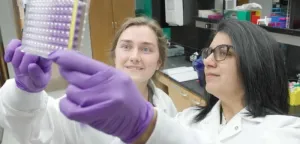(Press-News.org) Increasing ventilation in child-care settings may not always be effective at preventing flu virus spread, according to a new study published by a team of researchers at Emory University, University of Pittsburgh School of Medicine, and Virginia Tech.
The spread of flu viruses is commonly studied in animal models that don’t mimic the real-life scenarios of the human experience, making it difficult to evaluate strategies that will be effective in common places where disease spreads rapidly, such as childcare settings. As reported online and in a coming print issue of the journal Proceedings of the National Academy of Sciences (PNAS), the team created a play-based model using ferrets to study the spread of flu in a setting that closely mimics a childcare venue in order to help tackle this issue. In their scenario, one infected ferret interacted with four other uninfected animals for a few hours within a playpen area that also included numerous toys and surfaces.
“Ferrets are great models for kids because they are playful animals and exhibit many behaviors seen with children in real life, such as close-contact interactions and playing with toys,” says Seema S. Lakdawala, PhD, corresponding author and associate professor at Emory University's School of Medicine. “Additionally, they also exhibit key symptoms of influenza that are seen in infected humans.”
Testing out both high and low ventilation conditions, the researchers examined how many ferrets got sick and the levels of virus in the air and on surfaces. They found that approximately the same number of animals got sick in both venitilation conditions. Although the team did observe slightly less virus in the air with higher ventilation, they measured similar amounts of virus on objects within the playpen. The authors also tracked the behaviors of the ferrets in the playpen and found that the longest ferret-ferret interactions did not define which ferrets got sick. Therefore, other close-range behaviors and/or a combination of interactions with contaminated toys and the infected donor may be more important for virus spread in a close-range exposure scenario.
“Our findings highlight the importance of mimicking real-world settings when examining how interventions affect virus transmission,” says lead author Nicole Rockey, PhD, a former post doc in Lakdawala’s lab and now an assistant professor at Duke University. “This has significant implications for devising public health strategies that can more effectively stem the spread of infections.”
While increased ventilation was not effective in reducing flu virus spread in this play-based model, it may still prove effective in other situations, like within office buildings with adults that do not exhibit as much close-contact behavior as children.
“The need for multiple layers of interventions is critical to reduce the spread on respiratory viruses in communities. There is no magic bullet that will eliminate all transmission,” says Lakdawala.
This research is part of a larger program aimed at mitigating the spread of flu in childcare centers, and includes surveillance in childcare centers in Michigan with aerosol sampling devices designed by researchers at Virginia Tech and University of Michigan.
“The ferret playpen model allows us to manipulate the environment in a real-world-like scenario so that we can test the potential of different interventions deployed in childcare centers,” says Linsey Marr, PhD, professor at Virginia Tech and lead principal investigator for the MITIGATE FLU program.
Future work using the the play-based ferret model will focus on defining the specific behaviors that contribute to the successful spread of flu virus from an infected ferret to a recipient animal. Additionally, the team hopes to use this model to examine whether other interventions, such as air filtration devices, reduce transmission in order to help inform implementation of mitigation strategies in the childcare settings.
Citation: Seema Lakdawala, Nicole Rockey, Linsey Marr, Valerie Le Sage, Meredith Shepard, Anice C. Lowen, Herek Clack, Aaron J. Prussin II. “Ventilation does not affect close range transmission of influenza virus in a ferret playpen setup,” Proceedings of the National Academy of Sciences (PNAS). Aug. 6, 2024. DOI: 10.1073/pnas.2322660121.
Funding: This research was funded by Flu Lab, an organization that supports efforts to advance innovative solutions to persistent problems in the prevention and treatment of influenza.
Media Contact:
Georgia Parmelee
Director of Health Sciences Media Relations
Emory University
georgia.robert.parmelee@emory.edu
END
Increased ventilation not effective in reducing influenza virus spread in play-based model, Emory study finds
2024-08-06
ELSE PRESS RELEASES FROM THIS DATE:
Lonely people tend to have more nightmares, Oregon State University research shows
2024-08-06
CORVALLIS, Ore. – People who are lonely are more apt to have bad dreams, according to a collaboration that included an Oregon State University scientist.
The findings are important because both loneliness and sleep disorders are serious public health issues, said OSU’s Colin Hesse. They are connected to increased risk of heart disease, stroke and premature death.
In a paper published in the Journal of Psychology, Hesse and researchers at the University of Arizona, the University of Tampa and Whitworth University note that stress ...
UC Irvine-led team reveals how TREM2 genetic mutation affects late-onset Alzheimer’s
2024-08-06
Irvine, Calif., Aug. 6, 2024 — Researchers led by the University of California, Irvine have discovered how the TREM2 R47H genetic mutation causes certain brain areas to develop abnormal protein clumps, called beta-amyloid plaques, associated with late-onset Alzheimer’s disease. Leveraging single-cell Merfish spatial transcriptomics technology, the team was able to profile the effects of the mutation across multiple cortical and subcortical brain regions, offering first-of-their-kind insights at the single-cell level.
The study, recently published online in the journal Molecular Psychiatry, compared the brains of normal mice and special mouse models that undergo ...
Considering the patient’s perspective in inducible laryngeal obstruction care
2024-08-06
Inducible laryngeal obstruction is a breathing disorder characterized by unwanted vocal fold closure having the potential to restrict breathing at times.
It’s estimated that between 3-12% of patients with dyspnea complaints have inducible laryngeal obstruction.
Patients with inducible laryngeal obstruction are thought to make up to 22% of patients with frequent emergency room visits due to sudden onset dyspnea.
While experts know how to treat the condition, there’s not much formal research about what patients with the disorder experience ...
Living with a killer: How an unlikely mantis shrimp-clam association violates a biological principle
2024-08-06
Media
When clams gamble on living with a killer, sometimes their luck may run out, according to a University of Michigan study.
A longstanding question in ecology asks how can so many different species co-occur, or live together, at the same time and at the same place. One influential theory called the competitive exclusion principle suggests that only one species can occupy a particular niche in a biological community at any one time.
But out in the wild, researchers find many instances of different species that appear to occupy the same ...
Researchers urge united nations to reject growth-driven framework in favor of lower population and consumption
2024-08-06
In a new peer-reviewed article in The Journal of Population and Sustainability, demographic experts are urging the United Nations to reject the current “‘growth’ paradigm which treats Earth and its nonhuman inhabitants as mere resources” and to take the lead in “contracting the large-scale variables of the human enterprise” in order to “forge a path out of multiple environmental and social crises,” and “reverse our advanced state of ecological overshoot.”
Earth Overshoot Day, the date when humanity’s demand on nature’s resources surpasses Earth’s capacity ...
Future enterovirus outbreaks could be exacerbated by climate change
2024-08-06
Outbreaks of hand, foot and mouth disease (HFMD), which causes fever and rash in young children, typically occur in the summer months. Similarly, historic cases of polio were observed in the summer months in the United States. Both diseases are caused by different species of enteroviruses, a large genus of RNA viruses. However, the drivers of the seasonal patterns of these diseases have remained somewhat unclear.
A common set of drivers can explain the timing of outbreaks of both HFMD and polio according a recent study by researchers at Brown University, Princeton University ...
Genetic ‘episignatures’ guide researchers in identifying causes of unsolved epileptic neurological disorders
2024-08-06
(Memphis, Tenn. – August 6, 2024) To effectively treat a disease or disorder, doctors must first know the root cause. Such is the case for developmental and epileptic encephalopathies (DEEs), whose root causes can be hugely complex and heterogeneous. Scientists at St. Jude Children’s Research Hospital demonstrated the value of DNA methylation patterns for identifying the root cause of DEEs, showing specific gene methylation and genome-wide methylation “episignatures” ...
Study explores effects of racial discrimination on Black parents and children
2024-08-06
URBANA, Ill. – Black Americans experience racial discrimination on a regular basis, and it is a cause of chronic and pervasive stress. It is known to contribute to elevated risk for poor mental health outcomes, but most research has focused on individuals. A new study from the University of Illinois Urbana-Champaign looks at the interpersonal effects of discrimination on parents and their adolescent children.
“A person’s experiences with racial discrimination are not just their own but may spill over into the ...
Wayne State University professor receives career achievement award from the Society for Health Psychology
2024-08-06
DETROIT — Mark Lumley, Ph.D., distinguished professor of psychology in Wayne State University’s College of Liberal Arts and Sciences, was recently awarded the 2024 Nathan W. Perry, Jr. Award for Career Service to Health Psychology from the Society for Health Psychology.
The Society for Health Psychology is a national nonprofit that seeks to improve the lives of individuals and society by promoting health, preventing illness and improving health care through research, practice, education, training and advocacy.
“I’m delighted and greatly honored for this recognition,” ...
Elephants on the move: Mapping connections across African landscapes
2024-08-06
URBANA, Ill. -- Elephant conservation is a major priority in southern Africa, but habitat loss and urbanization mean the far-ranging pachyderms are increasingly restricted to protected areas like game reserves. The risk? Contained populations could become genetically isolated over time, making elephants more vulnerable to disease and environmental change.
A recent study from the University of Illinois Urbana-Champaign and the University of Pretoria in South Africa demonstrates how African conservation managers could create and optimize elephant movement corridors across a seven-country ...





